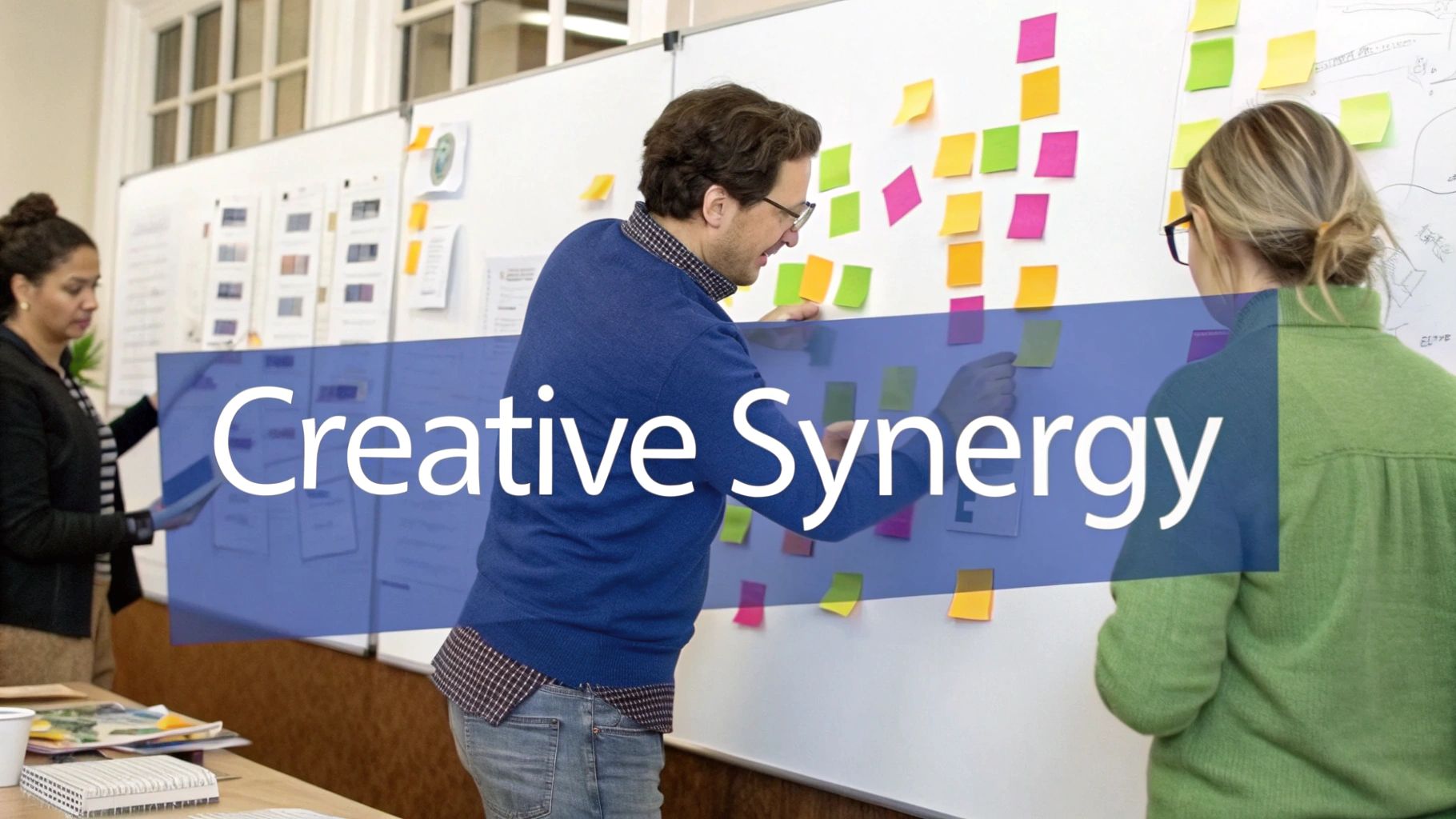Understanding the New Era of Digital Collaboration

Team collaboration looks dramatically different today than it did just a few years ago. Simple email threads and shared folders have given way to robust digital workspaces that enable seamless communication and coordination. This evolution reflects deeper changes in how teams operate, especially with the rise of remote and hybrid work arrangements. For organizations to stay competitive, adapting to these new ways of working isn't optional – it's essential.
Why Traditional Tools Fall Short
Email and shared drives, while familiar, often create barriers rather than bridges between team members. These conventional tools lack the real-time interaction capabilities that today's fast-moving projects demand. Teams spread across different time zones need solutions that can effectively handle both immediate and delayed communication needs. This raises an important question: what essential features do teams actually need to work together effectively?
The Power of Modern Platforms for Collaboration
Today's collaboration platforms solve these challenges by creating unified hubs where teams can communicate, share files, and manage projects in one place. By combining video calls, instant messaging, task tracking, and document collaboration, these tools help teams work smoothly regardless of location. The rapid growth in this sector speaks volumes – experts predict the collaboration software market will expand to $20 billion by 2032.
Synchronous vs. Asynchronous: Finding the Right Balance
Smart organizations have learned to blend real-time and asynchronous collaboration effectively. Video meetings enable immediate discussion and decision-making, while project boards and shared documents let team members contribute on their own schedule. This balanced approach works – many companies report productivity gains of up to 30% after finding the right mix of communication styles.
Key Factors in Platform Adoption
Several critical elements determine whether a new collaboration platform will succeed. First, it must be easy to use – complex interfaces that require extensive training often face pushback. Second, it needs to work well with existing tools to minimize disruption. Finally, the platform must deliver clear benefits that improve how teams work. Understanding these factors helps organizations choose tools that truly meet their needs.
The shift to digital collaboration has fundamentally changed how teams operate. By choosing the right tools and balancing different communication styles, organizations can work more effectively in this new environment. Success depends on carefully evaluating platforms based on team needs, usability, and integration capabilities – taking time to get these decisions right pays dividends in improved teamwork and productivity.
Choosing the Right Platform for Your Team's Needs

Picking the right collaboration platform is a critical decision that directly impacts how well your team works together. While it may be tempting to select the option with the most features, success comes from carefully matching the platform to your team's specific work style and needs. What works brilliantly for one group may fall flat for another due to fundamental differences in how they operate.
Defining Your Collaboration Needs
Start by getting crystal clear on what your team actually requires. Ask yourself these key questions:
- What are your primary communication methods? Think about whether your team relies mostly on chat, video calls, or email.
- How do you manage projects and tasks? Consider if you use Agile methods, Kanban boards, or traditional project plans.
- What types of files do you share most often? This could be design assets, code, documents, or other content.
- Where are your team members located? Factor in whether people work in one office, remotely, or a mix of both.
For example, a marketing team spread across different locations might prioritize seamless video conferencing and real-time document collaboration. A software team, on the other hand, would likely focus more on integrated code repositories, issue tracking, and agile project tools.
Evaluating Key Platform Features
After outlining your needs, you can assess platforms based on their core capabilities. Remember that not every feature matters equally – some will be essential while others may go unused.
Here are the most important features to examine:
- Communication: Look for strong instant messaging, video calls, screen sharing, and email integration.
- File Sharing and Management: Consider cloud storage space, version control, preview capabilities, and search tools.
- Task and Project Management: Evaluate task assignment, progress tracking, board views, timeline tools, and connection to project software.
- Integrations: Check how well it works with your current tools like CRM systems, marketing platforms or design apps. For example, BugSmash makes creative feedback simple for marketing and product teams.
- Security: Assess data protection, access controls, and compliance certifications.
- Usability: The interface should be intuitive enough that people can start using it quickly.
The Impact of Team Size and Budget
Your team's size and available budget play a major role in platform selection. Small teams with modest budgets often do well with free or low-cost options that cover the basics. Larger organizations typically need more advanced capabilities, stronger security, and dedicated support. The global collaboration software market, expected to hit $20 billion by 2032, offers options for teams of all sizes and budgets.
Don't forget to factor in indirect costs like training time, setup work, and ongoing maintenance. A platform that's hard to use can hurt productivity and end up being more expensive long-term, even if the subscription seems affordable.
Making a smart platform choice is an investment that directly affects how well your team collaborates. By thoroughly evaluating your needs, examining platform capabilities, and weighing budget considerations, you can find a solution that truly helps your team succeed.
Mastering Remote and Hybrid Collaboration
Teams today work from different locations, time zones, and schedules – making effective collaboration essential for success. Quality collaboration platforms have become as crucial as a physical office, enabling teams to communicate, share work, and maintain strong connections regardless of location. To build a productive remote or hybrid workplace, organizations need tools that truly support their teams' needs while avoiding common issues that can derail virtual collaboration.
Building Bridges Across Distances: Key Features for Remote Teams
For distributed teams, collaboration platforms act as their virtual headquarters where all work takes place. The right features make or break remote collaboration success. Clear communication is critical – teams need reliable video conferencing, instant messaging, and integrated channels to stay connected across locations. For instance, when team members work in different time zones, asynchronous tools like shared project boards and documents help maintain momentum even without real-time interaction.
Teams also require robust file management capabilities to keep work organized and accessible. Real-time document editing prevents version confusion and helps workflows stay on track. Features like version history, permission controls, and powerful search help teams work efficiently while avoiding mistakes from outdated or misplaced files. Without these core capabilities, remote collaboration quickly becomes frustrating and productivity suffers.
Avoiding Virtual Collaboration Pitfalls: Strategies for Success
Having great collaboration tools is just the start – teams need strategies to use them effectively. Many organizations overlook the human side of remote work. Beyond the technology, teams need ways to build trust, stay connected, and maintain engagement when working virtually. This includes virtual team activities, casual communication channels, and clear expectations around availability and response times.
Organizations must also actively prevent isolation in remote environments. Well-designed collaboration platforms can strengthen team bonds by creating inclusive virtual spaces. Dedicated social channels, regular virtual coffee breaks, and meeting practices that encourage full participation help everyone feel valued and heard. When organizations neglect these social aspects, team morale and productivity decline, often leading to turnover.
Fostering Engagement and Building Trust in a Digital Workspace
Keeping distributed teams engaged requires intentional effort and communication. Regular check-ins, clear timelines, and consistent feedback help align everyone's work and maintain motivation. Leaders need to adapt their approach for virtual teams, emphasizing clear communication, empathy, and shared purpose. Teams can also use collaboration platforms to celebrate wins and recognize contributions, creating a more positive work environment.
Trust in remote teams grows through transparency and open dialogue. Collaboration platforms support this by providing visibility into work progress, decisions, and team activities. When everyone can easily access information and updates, it builds confidence and accountability. Including social interaction in virtual workspaces also strengthens relationships between team members. Simple practices like casual chat channels or virtual social events help create community. With focus on these key elements, organizations can use collaboration platforms to both drive results and build strong team connections in a remote-first world.
Essential Features That Drive Team Success

The right collaboration tools are only as good as their core features. Let's explore the key elements that help teams work better together and achieve measurable results. Understanding these foundational features is crucial for making the most of any collaboration platform.
Communication: The Heart of Collaboration
Clear communication is essential for any successful team. Modern collaboration platforms need to provide multiple ways for team members to connect, from instant messaging for quick updates to high-quality video calls for face-to-face discussions. For example, design teams can use video conferencing to review mockups together while sharing screens to examine details in real-time. Bringing email into the same platform helps keep all conversations in one place, making it easy for everyone to stay informed and aligned.
File Sharing and Management: Streamlining Workflows
Easy file handling is another must-have feature. Teams need plenty of cloud storage to keep their files accessible from anywhere, which is especially important with remote and hybrid work becoming standard. Good version control helps track changes and fix mistakes quickly, while preview features and powerful search make it simple to find exactly what you need. When teams can work on documents together in real-time, they spend less time hunting for files and more time getting work done.
Task and Project Management: Keeping Teams on Track
Clear task assignment and project organization are vital for success. Look for tools that make it easy to assign work, monitor progress, and see project timelines at a glance – whether through Kanban boards, Gantt charts, or other visual methods. This helps every team member understand their role and how it fits into the bigger picture. Connecting with dedicated project management tools gives teams even more ways to plan and track their work effectively. For more insights on team collaboration, check out our guide on collaborative feedback tools.
Integrations: Connecting the Dots
The ability to work smoothly with other business tools makes a huge difference in team productivity. When your collaboration platform connects easily with your CRM, marketing tools, and other key software, teams can work more efficiently without constantly switching between apps. This creates a smoother workflow and helps teams focus on their actual work rather than managing multiple systems. With seamless data sharing between tools, teams can make better decisions based on complete information. As more companies invest in collaboration software, choosing a platform that works well with your other tools is a smart way to support your team's success now and in the future.
Implementing Platforms That Actually Get Used
Getting teams to embrace and actively use new collaboration platforms takes more than just making them available. Success requires careful planning and a focus on driving real adoption by making the platform an essential part of how teams work together. The key is moving beyond basic rollouts to create lasting usage patterns that stick.
Overcoming Resistance to Change
When introducing new tools, teams often resist changes to their familiar workflows. The best way to handle this resistance is to address it openly and directly. Focus your communication on how the platform solves specific problems teams face today – like saving time on repetitive tasks, reducing email overload, or making project coordination simpler. By emphasizing these practical benefits rather than technical features, you help teams understand the real value of making the switch.
Building Enthusiasm and Buy-In
One of the most effective ways to drive adoption is to identify and empower "champions" within different teams who are excited about using the new platform. These champions can demonstrate its value to their peers, provide day-to-day support, and share feedback to improve the implementation. Supporting this grassroots approach with fun team challenges or recognition programs can create friendly competition and motivate people to engage. When teams see their colleagues actively using and benefiting from the platform, they're more likely to embrace it themselves.
Practical Approaches to Training and Integration
Rather than overwhelming teams with lengthy training sessions, break learning into shorter, focused modules that teach specific features relevant to different roles. Let people learn at their own pace and practice with real work scenarios. It's also crucial to ensure smooth integration with existing tools – forcing teams to dramatically change how they work will only create frustration. Choose platforms that connect well with your current tech stack to minimize disruption. You might be interested in: How to master effective feedback loops.
Measuring Success and Iterating
Successful platform adoption requires ongoing attention and refinement. Track key metrics like active usage, feature adoption, and team feedback to understand what's working and what needs adjustment. Regular check-ins through surveys and conversations help you spot issues early and adapt your approach. With collaboration software projected to be a $20 billion market by 2032, taking a thoughtful, iterative approach to implementation helps maximize the return on this important investment. The most successful platforms become truly embedded in how teams work because leadership stays focused on measuring and improving the experience over time.
The Future of Collaborative Work

As workplace collaboration continues to evolve, organizations need to stay informed about new developments that are reshaping how teams work together. Recent advances in technology are making it easier than ever for teams to collaborate effectively and achieve better results, regardless of physical location or time zones.
AI-Powered Collaboration: The Next Frontier
Artificial intelligence is changing the fundamental nature of teamwork. Smart tools now handle routine tasks automatically, analyze data for insights, and even translate conversations in real-time for global teams. For instance, modern project management platforms can spot potential issues before they arise, while communication tools automatically create summaries of key discussions. By taking care of these time-consuming tasks, AI allows teams to concentrate on strategic thinking and solving complex problems creatively.
Immersive Collaboration Environments: Bridging Physical Distance
Virtual reality and augmented reality are creating spaces where remote teams can work together as if they were in the same room. These technologies enable architects to jointly develop 3D building models and let engineers troubleshoot equipment problems from anywhere in the world. The result is a much more natural and engaging way to collaborate compared to standard video calls, helping teams form stronger connections despite being physically apart.
The Rise of Decentralized Collaboration: Blockchain and Web3
New collaboration models are emerging through blockchain technology and Web3 platforms. Teams can now use decentralized autonomous organizations (DAOs) and token-based incentives to better align goals and manage projects. These systems also provide improved security and transparency for sensitive collaborative work. As these tools become more established, they're opening up new possibilities for how distributed teams can work together effectively.
Beyond the Hype: Focusing on Practical Applications
While these new technologies show great promise, it's essential to evaluate them based on real team needs rather than getting caught up in buzzwords. Success requires understanding your specific collaboration challenges and choosing tools that actually solve them. With the global collaboration software market expected to reach $20 billion by 2032, organizations should focus on implementing solutions that deliver measurable improvements in team performance and results.
Streamline your team's creative feedback process with BugSmash, a comprehensive platform built for efficient reviews and annotations. Try BugSmash today!